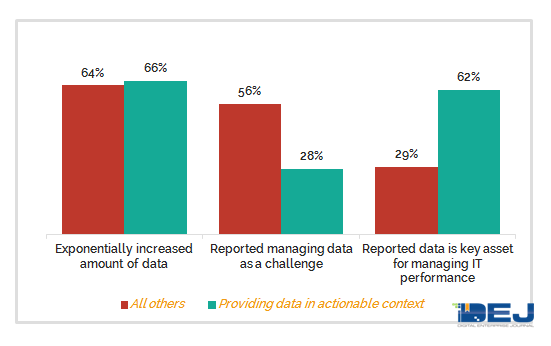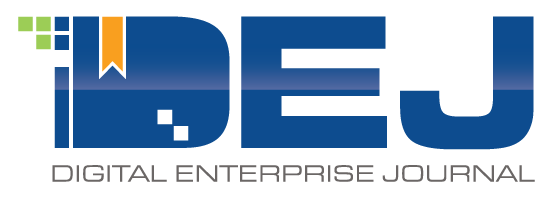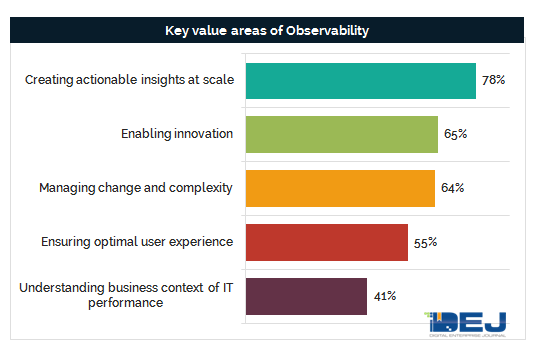DEJ recently surveyed more than 3,000 user organizations to capture key user requirements and goals for managing IT performance in 2022. Results and analysis of this research will be published in DEJ’s upcoming study on the state of IT performance management. The study will also provide actionable, data-backed recommendations around capabilities that can help organizations address each of their top goals and challenges.
This DEJ’s Research Note provides a summary of key 28 areas that are shaping IT performance markets and are analyzed in the study.
1 – Finding the right balance between release velocity and reliability
54% of organizations reported delays in new releases due to performance issues. As both speed to the market and the quality of user experience are increasingly becoming sources of competitive advantage, organizations are facing a number of challenges in addressing each of these areas. The study reveals a number of capabilities that organizations are deploying to address this area and they range from having full visibility into factors that impact reliability, orchestration and automation capabilities to improving collaboration between teams, change management capabilities and a proactive approach to managing IT performance.
2 – User experience – from monitoring to management and assurance
28% increase in the importance of managing the performance of digital services from the end user’s perspective over the last 12 months. The study shows that organizations are looking beyond visibility into the quality of user experience and taking a strategic approach for employee and customer management. In order to achieve this goal, organizations in DEJ’s research reported the need for a broad set of capabilities, such as understanding technology adoption and engagement, ability to prioritize problems, testing from the end-user perspective, asset intelligence and automation and incident prevention.
3 – Enabling focus on higher value work
68% of an IT team’s time is spent on tasks that do not contribute to key business outcomes. DEJ’s research shows that, on average, 61% of trouble ticket escalations could have been avoided. Additionally, DEJ’s recent study on the Total Business Impact of IT Performance found that, on average, $3.36 million is being lost annually due to Engineers not focusing on business critical tasks. This upcoming study reveals a set of capabilities that organizations can be deploying to address this area and they range from context-based automation to platforms for aligning technology and business initiatives.
4 – Modernizing IT service delivery organization
45% identified their IT organization and processes as the key obstacle for maximizing the value of technology deployments. The study shows that in order to be able to leverage to achieve their key business goals, organizations need to make changes in the way their IT organizations operate. Some of the key principles that leading organizations are built on include resilience, seamless collaboration, focus on business outcomes, continuous learning and being predictive and quick to respond.
5 – Kubernetes management – complex challenge that is well worth addressing
Organizations reported, on average, a 6.8x improvement in time to market after deploying Kubernetes. Additionally, more than 50% of organizations reported that they experienced challenges in 8 different areas after deploying Kubernetes. The study shows that in order to maximize the value of Kubernetes, organizations have to understand that legacy management tools are not as effective in these new environments and develop a set of capabilities that would help them cope with new challenges. Some of the most impactful capabilities revealed in the study include automation, a new breed of monitoring and observability solutions and platforms for centralized, full lifecycle management, cost administration, installation and compliance.
6 – Evaluating vendors – new criteria becoming top-of-mind
32% increase in the number of organizations that are using “ability to quantify the business impact” as the key selection criteria over the last 18 months. The study shows that organizations are increasingly changing their criteria for evaluating vendors with attributes such as impact on business outcomes, scalability, time to value, fit with existing tools and capabilities for real-time management becoming more critical for them.
7 – Everything in the business context
27% average increase of the impact of issues with IT performance on revenue in the last 12 months. DEJ’s recent study showed that managing IT performance is having an enormous impact on the business across four key areas: 1) competitive advantage; 2) ROI; 3) cost of not acting; 4) impact on business outcomes. This upcoming study found that this impact is constantly increasing and reveals capabilities that organizations should be deploying to measure, manage and improve the impact of IT performance on the key business goals.
8 – Visibility into inefficiencies
68% of organizations do not have visibility into how their IT resources are being used. Business and IT executives that participated in DEJ’s recent research reported improving efficiency as the #1 business goal for 2022 (83% of organizations). However, in order to achieve this goal, organizations need to gain visibility into the areas where they are experiencing inefficiencies. The study shows that organizations are struggling in a number of these areas, such as visibility into cloud cost and application-specific resource utilization and understanding cost of management and observability. In order to address these issues, organizations are finding capabilities such as asset intelligence and value stream management (VSM) highly effective.
9 – Understanding the true value of Observability
Organizations are becoming increasingly interested in adopting Observability capabilities, but they are often confused about what this concept means to them. The way it is commonly defined, the concept of Observability includes three key pillars – logs, metrics and traces. However, the study shows that organizations see the true value of Observability in five key areas: 1) creating actionable insights at scale; 2) enabling innovation; 3) managing change and complexity; 4) understanding a business context of IT performance; and 5) ensuring optimal user experience. The study also reveals a set of Observability capabilities that are having the strongest impact on performance.
10 – Proactive management is a must
Organizations that can prevent 80% (or more) performance incidents are saving, on average, $32.7 million. The study also found that an inability to prevent performance issues before users are impacted is the #1 challenge for managing IT performance. This is a complex issue and addressing it requires a broad set of capabilities in both pre-production and production. Some of the capabilities that were analyzed in the study include frameworks for incident response before they happen, AIOps capabilities and end-to-end test automation.
11 – Optimization as a key enabler of digital businesses
61% of IT spend is allocated to resources that are underutilized. The study shows that optimization is becoming increasingly important for organizations as they are looking to address business critical challenges such as finding the balance between resource utilization and performance and making decisions about IT assets in the business context. The research also identified that capabilities such as automation and AI and application traffic optimization are having a strong impact on addressing these challenges.
12 – Modernization enablement requires a strategic approach
71% of organizations reported that performance issues due to modernization projects were preventable. The study shows that leading organizations (top 20% based on performance) are starting their modernization project better prepared, as compared to their peers. These organizations are deploying strong capabilities in the planning process and also putting more emphasis on testing and having more visibility and intelligence. These organizations are also taking a holistic approach that allows them to have control over the entire process and the ability to avoid disruption.
13 – Managing change as a competitive differentiator
67% of organizations don’t have the ability to identify change(s) in their environments that caused performance issues. The study also reveals a 4.1 times increase in new technology deployments and updates over the last 24 months. With the amount and velocity of change constantly increasing, organizations are looking to build capabilities that will turn managing change from a challenge to an opportunity. The study shows that in order to manage change, organizations are enhancing their automating and testing capabilities, looking to gain more intelligence into change impact and patterns and proactively taking steps to reduce risk.
14 – Managing cloud native journey
Organizations that are taking a cloud native approach are 64% more likely to create new technology-driven revenue sources. Taking a cloud native approach results in a number of measurable business benefits. However, the study shows that organizations that choose to go on this journey should be aware that, from the IT performance management perspective, managing these environments is a completely new game from many viewpoints. The study reveals the top challenges and capabilities for addressing them that organizations should be aware of when taking a cloud native approach.
15 – Modernizing IT Operations – way beyond troubleshooting
42% increase in the number of organizations that listed “enabling innovation” as the key driver for modernizing IT Operations over the last 2 years. The study shows that the key value areas for IT Operations are shifting from traditional troubleshooting and cost reduction to managing change and enabling innovation. In order to support this transformation, organizations are increasingly looking to deploy capabilities such as automation, AIOps focused on business outcomes, a service-centric approach, correlation and advanced analytics and a unified platform for managing different types of IT environments.
16 – War for talent and the role of technology
30% of organizations reported employee churn due to lack of IT performance management capabilities. The study shows that finding and retaining the right talent is one of the key challenges for managing modern dynamic environments. As a result, organizations are trying to streamline their processes by deploying capabilities that would reduce frustration of their IT staff and allow them to focus on tasks that drive innovation and growth.
17 – Cloud management – cost, performance, innovation
Only 19% of organizations are satisfied with their ability to control each aspect of cloud management. DEJ’s recent study found that, on average, organizations are losing $21.58 million annually due to a lack of capabilities for managing cloud performance. This upcoming study shows the full complexity of addressing each aspect of cloud management and highlights capabilities and strategies that enable organizations to maximize their cloud deployments.
18 – Enabling new and unique customer experiences is the name of the game
41% increase in “enabling new and unique customer experiences” as the key driver for investing in IT performance technologies over the last 2 years. The study found that, for leading organizations, managing all major aspects of IT performance comes down to one goal – creating business value by enabling unique user experiences. Working towards achieving this goal cuts across all the key areas – from efficiency and reliability, real-time data management to managing change, creating actionable insights and automation. The study also found that addressing this goal is becoming increasingly difficult, as organizations are reporting that user expectations for experience and performance are constantly increasing.
19 – New strategies for addressing performance incidents
The study found that a technology market that used to be known as “IT Incident Management” is going through a major transformation. Adoption of new technologies, increasing expectations for performance and growing complexity are driving organizations to rethink their approaches to addressing performance incidents. What used to be known as a technology class and processes focused on troubleshooting and “firefight” is an emerging practice centered around continuous learning, context-based automation and AI, a new generation of collaboration and knowledge management capabilities.
20 – Data, context and creating actionable insights as a focal point

The study shows that the data, and capabilities for managing it, is becoming the key asset for managing IT performance. The research also shows that the evolution of using the data in analytics in the enterprise goes along this path: context – actionable insights – answers. Each of these steps requires a data strategy to be the core part of an organizations’ IT performance efforts and its execution is critical for achieving key goals.
21 – Key attributes of leaders in enabling innovation
Leading organizations are 3.8 times more likely to report orchestration capabilities as a key enabler for innovation, as compared to all others. The study shows that processes for enabling innovation that these organizations are putting in place are based on the same attributes. Some of these attributes include continuous everything, end-to-end coverage, integration, automation, intelligence, collaboration, resilience and scalability. As a result, these leading organizations are able to generate 3.2 times more revenue from new digital services, as compared to all others.
22 – Automation – from emerging capability to key requirement
36% increase in the number of organizations reporting automation capabilities as the key enabler over the last 18 months. The study shows that different flavors of automation capabilities are having a very strong impact on each of the goals that organizations are trying to achieve. The research also reveals a 37% increase in manual tasks that are “not humanly possible to complete” over the last 12 months. As automation is becoming increasingly important for managing IT performance, organizations should be taking a more strategic approach when selecting technology solutions and ensure that their capabilities are aligned with their use cases and management goals.
23 – Major overhaul of IT performance monitoring markets
47% of organizations reported that effectiveness of their IT performance monitoring solutions declined over the last 2 years. New requirements for monitoring the performance of complex and dynamic environments are causing major changes in approaches that organizations are taking and the study identifies key capabilities that digital businesses are deploying. Some of the most critical capabilities include full stack visibility, correlation and topology mapping, providing actionable insights in business context, real-time, automation and AI based capabilities and true visibility into user experience.
24 – Managing software delivery – a windy road to better, faster and efficient
57% of organizations reported a lack of context-based automation capabilities as a key challenge for managing software delivery. The study also shows finding the right balance between code quality, speed to the market and resource utilization as a challenge for 69% of organizations. The research reveals a set of technology, process-related and organizational capabilities that leading organizations are deploying to achieve this goal.
25 – Key use cases that are calling for new competencies
59% of organizations reported that their ability to resolve performance issues declined after deploying hybrid cloud environments. The study shows that expertise in specific use cases is one of the key selection criteria for user organizations. This research also identified use cases that are becoming most prevalent, such as hybrid cloud and managing remote work, and key capabilities required for their management. The study also analyzed dynamics around emerging use cases such as edge, serverless and infrastructure as code.
26 – Increasing importance of a unified approach for addressing key goals
Organizations that are leveraging unified platforms for managing IT performance are experiencing a 32% higher reliability, as compared to all others. Forty-four percent of organizations in DEJ’s 2020 study reported fragmented tools as one of the key challenges of managing IT performance. This upcoming study revealed that using a unified platform for bringing together different aspects of performance management has a strong impact on results. This is especially true in areas such as performance monitoring, collaboration, log management, managing reliability and asset management.
27 – Most impactful and emerging capabilities
Organizations that are leveraging AI-enabled capabilities are 58% less likely to experience issues with application performance, as compared to all others. The study identified a group of leading organizations (top 20%) based on performance and analyzed capabilities they are more likely to have in place, as compared to others. Some of the key capabilities identified include self-service, orchestration, log management and different flavors of automation.
28 – Resilience as a key attribute of digital businesses
41% increase in the number of organizations that listed “improving resilience” as their key goal for managing IT over the last 18 months. The study shows that organizations are increasingly understanding that in order to deal with a rising amount of change and complexity, they need to manage each area of their business with building resiliency in mind. The study also reveals that organizations that are deploying strong orchestration and observability capabilities and managing testing and recovery plans are more likely to achieve their goals for resilience.













